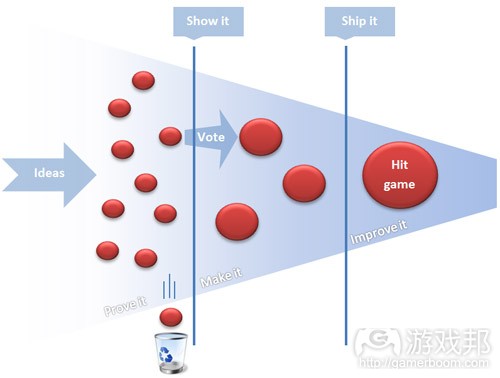分享游戏工作室开发项目的流程及方法
作者:Samuel Rantaeskola
在过去几年中,我遇到大量经验丰富的主机游戏开发者,他们现在都转向制造小型游戏项目了。我从他们口中听到的普遍情况是,他们已经对充满挑战的环境产生厌倦,他们希望重新找到自己的根。我在2010年也有同感,所以绘制了一个如何将大型工作室转向为小型开发团队的方法。这种开发方法与今天许多成功开发者所使用的方法极为相似,即部分自我过滤,部分市场筛选的突击方法。也就是,尽量制作更多游戏以便推出成功之作。但这里要解决的问题是我们无法确定瞬息万变的市场需求是什么,也不能依赖少数人来预测市场走向。
方法
(这个图表显示了游戏从原型到可发售版本,最后成为成功游戏的各个阶段。)
这是目前为止,最适合富有才华的开发者在没有太多监管的环境下制作优秀游戏的最有效方法。将失败控制在早期阶段,并时常发现失败是一个关键要素,第二是找到成功游戏并快还将其开发为成品。这需要集体智慧,而不是由创意总监来引导和审查,人人都应该是创意决策者。
在解释这个方法之前,让我们先制作一些假设:
*我们有50名拥有不同专长的杰出开发者。
*我们的资金至少够我们在半年内开发游戏。
第一周:创意种子
召集开发者开启一个新的开发周期。目标是想出大量能够制作成原型的简单理念。
挑选一系列理念后,由团队中5名以内的开发者创造原型。
我们有50名开发者,所以应该能够提出10-15个可投入制作阶段的游戏理念。
第四周末尾:证明理念
此时所有的原型都应该完工了。整个公司会面并查看现成的原型。每个原型的用途是证明该游戏理念具有趣味性,开发团队还应提出一个制作可发售版本的大致方案。公司中人人都可为原型打分。得分最高者将进入开发阶段。
第五周开始:制作游戏
我们现在有一些优秀的原型。第一步就是创建一个备份表,描述将其制作成可发售版本所需要完成的工作,以及发布游戏后如何扩展理念的大致想法。
原型团队现在可以扩展人数(游戏邦注:调用被抛弃原型开发团队的成员),这样每个原型都可以在12周开发时间中转变为可发布版本。
第16周末尾:发布游戏
此时所有投入开发阶段的原型都应该发布到目标平台。发布游戏之后,团队应该花点时间营销和推广游戏,我们可不想分割营销与开发这两个环节。之后团队将从新原型入手开始一轮循环。
优化游戏
如果游戏获得成功,开发团队就需要快速执行长远的开发计划,确保维持人们对游戏的兴趣。团队成员也将从当前分配的任务转向深度开发热作的角色。游戏将投入持续开发循环,进行定期更新。
潜在缺陷
因为我实际上还没有尝试过这个方法,所以我只能预测其中可能存在的问题:
*自我组织能力——团队应由那些极具创意、富有才华,能够自我激励的成员组成。他们是每家游戏开发商的抢手人才,因此非常难找。
*资金流——如果第一批游戏失败了,团队很可能马上就入不敷出。
*投票——这是我最不确定是否具有可行性的一个要素。其中风险在于,大家都看好自己的原型,因此投票阶段可能会产生一些内部分歧。
*专注——要制作一个既能让团队保持专注又不会过于苛严的工作框架实为一大挑战。
总结
有许多公司采用的是类似的方法,我认为只要休闲游戏领域仍在繁荣发展,这种方法就仍会具有可行性。其中风险在于成功会降低团队效率,当一系列游戏成为热作之后,工作室就会从创意工场转变成一个基于服务的机器。为避免出现这种情况,工作室应持续发掘人才,不断填补空缺。(本文为游戏邦/gamerboom.com编译,拒绝任何不保留版权的转载,如需转载请联系:游戏邦)
Have fun making money and games!
by Samuel Rantaeskola
The following blog was, unless otherwise noted, independently written by a member of Gamasutra’s game development community. The thoughts and opinions expressed here are not necessarily those of Gamasutra or its parent company.
Want to write your own blog post on Gamasutra? It’s easy! Click here to get started. Your post could be featured on Gamasutra’s home page, right alongside our award-winning articles and news stories.
Over the last years I have met a large number of seasoned console game developers that are now creating smaller games. The common story I hear from them is that they are tired of the challenge riddled environment; they want to go back to their roots. In 2010 I had similar feelings, so I was sketching on a method on how to transfer a large studio to a garage-of-garages. The development method I was drawing up is very similar to the approach that many successful developers are using today; a partly self-filtered, partly market-filtered shotgun approach. Basically, it’s about creating as many games as possible to be first to the next thing. The problem to solve is that we can’t be sure what the rapidly changing market is looking for, and we can’t rely on a few people to be able to predict it.
The method
A diagram showing the phases of taking a game from prototype to shippable and finally maintenance of the successful games.
The method is by far most efficient in an environment where talented developers can make great games without much supervision. Failing early and often is one key ingredient; the second is to capture successful games and rapidly develop them further. It relies on collective wisdom, rather than creative leads that directs and reviews; everyone is a creative decision maker.
Before I explain the method, let’s make a few assumptions:
•We have 50 talented developers with different competencies.
•We have at least enough money enough to fund development for at least half a year.
Week 0 – Creative seeding
A new development cycle starts with all available developers gathering. The goal is to come up with a number of simple concepts that can go into prototyping.
When a number of concepts have been selected, the developers form teams of maximum 5 to create prototypes.
With about 50 developers, we should have roughly 10-15 game ideas that go into production.
End of week 4 – Prove it
At this time all prototypes should be completed. The whole company meets up and looks at the current batch of prototypes. The purpose of each prototype is to prove fun; there should also be a rough plan on what is needed to make a shippable version. Everyone in the company grades the prototypes. The best ones are now moving into stage two of development.
Start of week 5 – Make it
We now have a small number of good prototypes. The first step is to build a backlog that describes the work left to a shippable state; as well as a rough idea on how to expand the concept after releasing it.
The prototype teams might now be expanded with people from scrapped prototypes, so that each prototype can be taken to a shippable state within 12 weeks of development.
End of week 16 – Ship it
All of the prototypes that were developed further should now be shipped to their intended target platform. After shipping the game the teams should now spend time helping on marketing the games, we don’t want to separate marketing from development. After a while the teams will go back to the start to fire a new barrel of prototypes.
Improve it
If a game is successful the team needs to be very fast to execute on the plan on further development, to make sure to maintain the interest in the game. Team members are now moving back from current assignment to hop on the further development of the hit. The game will move into a continuous development cycle which is focused on frequent upgrades.
Potential flaws
Since I haven’t tried the method in reality I can only speculate in the flaws of it. Here are some things that could be problematic:
•Self-organized talent – The team needs to consist of people that are very creative, talented and good at driving themselves forward. They are attractive to every game developer out there, so they are hard to find in abundance.
•Cash flow – If the first batch of games flop the team could run out of cash pretty rapidly.
•Voting – This is the component I’m most uncertain if it will work in reality. The risk is that people are so passionate about their prototypes that the voting creates internal friction.
•Focus – Creating a framework that keeps the organization focused while still not being restrictive can prove to be a challenge.
Summary
There are many organizations out there that are using a similar approach, and I think it can work as long as the casual segment is still booming. The risk is that success will slow the teams down, once a number of games becomes successful the studio will transform from a creative power house to a service focused beast. To prevent this, the studio needs to continuously find talent that can come in and start filling the barrels.(source:gamasutra)
上一篇:阐述游戏中失败的受挫感和趣味类型
下一篇:阐述游戏玩家类型的划分方法及意义













































 闽公网安备35020302001549号
闽公网安备35020302001549号